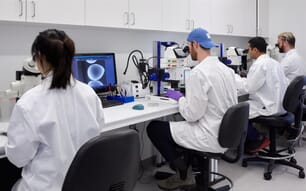Identity
Scylla serrata null, 2001 [Portunidae]
FAO Names: En - Indo-Pacific Swamp Crab, Fr - Crabe de palétuviers, Es - Cangrejo de manglares
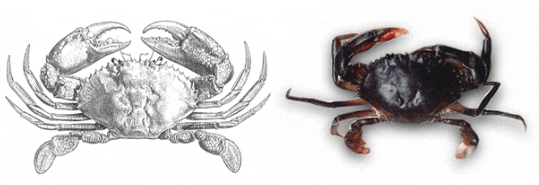
Biological Features
Carapace smooth, with strong transversal ridges. Gastric zone on the carapace with a deep H-shaped groove. Front with 4 broad lobes, all more or less in line with each other; 9 broad teeeth on each anterolateral margin, all them with similar size and projecting obliquely outwards. Strong chelipeds with well developed spines on the outer surface of carpus and on the anterior and posterior dorsal parts of propodus. Carapace green to almost black with legs that may be marbled.
View SIDP Species fact sheet
Images Gallery
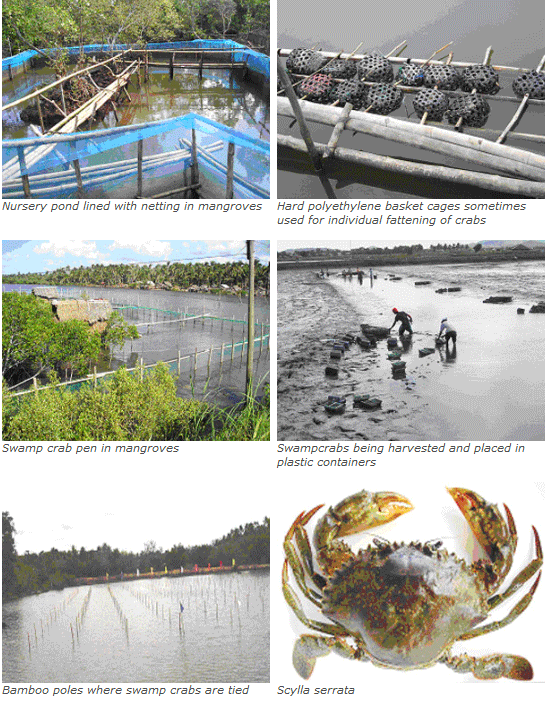
Profile
Historical Background
Indo-Pacific swamp crab culture began as early as 1890 in Guangdong, China. Interest in the farming of Scylla species has existed in tropical Asia since the 1970s. Farming of this species has developed from low density pond polyculture with fish and shrimp, using wild seeds introduced tidally or intentionally, to monoculture in ponds and pens. Swamp crab farming has become increasingly popular as a consequence of repeated disease outbreaks in shrimp ponds since 1994-1995. The integration of swamp crab culture and mangrove forestry (known as aquasilviculture) was introduced in the mid 1990s and is currently being practiced in many Asian countries.
Main Producer Countries
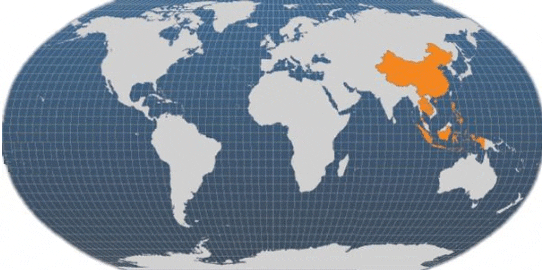
Main producer countries of Scylla serrata (FAO Fishery Statistics, 2006)
Habitat and Biology
Indo-Pacific swamp and mud crabs are found in the Indo-West Pacific region from East and South Africa to southeast and east Asia (from SE of China and Sri Lanka), and Northeast Australia. Also found in the eastern Pacific around the Marianas, Fiji and the Samoa Islands. Introduced into the Hawaiian Archipelago. S. serrata is the most widely distributed species among the genus Scylla.
Typically associated with mangroves in estuaries and sheltered coastal habitats, they are found in soft muddy bottoms where they dig deep burrows. Courtship and mating occur in estuaries. Mature S. serrata migrate offshore (up to 50 km) to spawn. The three other Scylla species prefer less saline water. Spawned eggs attach to the pleopod hairs of the abdominal flap. Eggs hatch into zoea and pass through five zoeal stages, after which they become megalopa. The megalopa moult once and assume the appearance of a crab. Crab instars to juveniles are found in estuaries, tidal flats and mangroves, where they burrow in mud or sand or seek shelter under fallen leaves, twigs, etc. Crab instars undergo several moults before attaining full maturity. As the male crab matures, the claws enlarge and the testes become massive, filling the cavity under the carapace. Males can grow up to 3 kg with 28 cm carapace width (CW). Mature females have wide and dark abdomens and dark orange ovaries that fill the cavity under the carapace.
Mud crabs may spawn at anytime during the year. The number of eggs produced may range from 1 to 6 million eggs in a single spawning. The spermatophores that have been deposited by males during mating are retained by the female even after moulting. One female can produce at least three batches of eggs with an interval of 41-46 days between the first and second spawning and 34 days between second and third spawning in the case of S. serrata.
The zoea and megalopa feed on zooplankton. Small crabs feed mainly on crustaceans, molluscs, worms and rarely on fish and plant matter. The sub-adult and adult crabs mainly eat molluscs and small crabs.
Production
Production Cycle
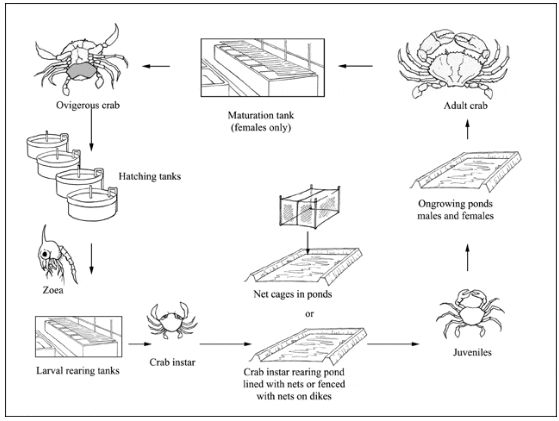
Production cycle of Scylla serrata
Production Systems
Seed Supply
Aquaculture production of swamp and mud crabs relies on wild-caught seeds. However, hatchery-produced seedstock has been used in the Philippines, Viet Nam and China over the last 5-10 years.
Hatchery Technology
Basic technology has been developed for the commercial seed production of swamp crabs. Females with mature gonads are obtained from the wild or from ponds, disinfected and optionally eyestalk-ablated. They are maintained in tanks provided with sand bottoms and shelters. A combination of two or more natural food items, such as fish, marine worms (polychaetes), shellfish and squid is fed at 5-10 percent of biomass or on an ad libitum basis. Formulated diet is fed at 1-3 percent in combination with natural food. Broodstock that spawn are retrieved, disinfected and stocked in individual tanks until the eggs hatch.The stocking density of zoeae is 80–100/litre. Zoeae are fed rotifers and Artemia nauplii, while early megalopae are offered processed food or >5-day old Artemia to provide larger-sized prey. Once the megalopae settle on the bottom, minced mussel meat and/or fish is given. Water is changed every 5 days until harvest, or changed after 3 days from 10-20 percent daily for early zoeae (Z1-Z3) to 40-50 percent daily until harvest. Various feeding and water management schemes have been developed to suit the diverse conditions in different countries. Existing shrimp hatcheries could shift to rearing swamp and mud crabs after slight modification of their facilities.
The performance of hatchery-reared crabs is comparable with those of the wild, given suitable pond conditions.
Nursery Technology
In the past, wild-sourced juveniles of ?3 cm CW were directly stocked into ponds and grown to market size. However, due to the declining catch of this size, even smaller crabs of 0.4-1.2 cm CW (crab instar 4-5) have now become acceptable to farmers. Hence, nursery systems have been developed.
Nursery systems that can be used for swamp and mud crabs sourced either from the wild or from hatcheries include net cages in ponds, net-lined ponds and ponds with net fences lining the dikes. The pond area ranges from 200 to 800 m2. The net cages (1 mm mesh size) with at least 20 m2 bottom surface areas are set in ponds. Crabs of less than 1.0 cm are grown to 1.5-2.0 cm CW in net cages at 20-50/m2 (Phase 1). Some farmers prefer larger crabs, so they ongrow them to 3.0-4.0 cm CW in ponds lined with nets or net fences lining the dikes at 5-10/m2 (Phase 2). The culture period is 3-4 weeks in each phase, depending on the desired size for stocking in ponds. Stocking density can be increased if the culture period is less than 4 weeks. Phases 1 and 2 may be carried out separately or sequentially using the same pond compartment but with reduced stocking density for Phase 2. A survival rate of 50-70 percent and 70-83 percent can be obtained in Phases 1 and 2, respectively. A minimum of 6 runs can be conducted per year.
In both systems, pond preparation is necessary prior to the stocking of crabs. Crabs are fed a combination of at least two food items such as minced low-value fish, shellfish, chicken trash, boiled corn, or formulated feeds at satiation once or twice daily. Water exchange is carried out during spring tides.
Packing and transport of crablets
Because smaller crabs moult frequently they are best transported in oxygenated plastic bags containing 2 litres of cool seawater at a density of 1 000 crablets for 0.4-0.6 cm CW, 500-750 crablets for 0.7-1.0 cm, and 250-500 crablets for 1.1-1.5 cm for a maximum of 8 h. Crablets of 1.5-2.0 cm CW may be transported in a box measuring 45L x 35W x 10H cm with wet cloth or sand at a density of 500-700 for maximum of 6 h.
Ongrowing Techniques
Scylla serrata is farmed under a number of different farming systems, namely polyculture, fattening and soft-shell crab farming. These systems are described separately below.
Polyculture
Due to the cannibalistic nature of swamp and mud crabs, polyculture in earthen brackishwater ponds (1-10 ha) is commonly practiced. Farmers do not normally stock crabs at densities greater than 1 000/ha, in order to reduce cannibalism. To maximize the space in the pond, crabs are cultured with one or two other commodities such as herbivorous fish (milkfish, siganids), omnivorous fish (tilapia) and shrimp. Two crops may be achieved in a year. In Viet Nam, the culture of mud crabs with tiger shrimp or fish (siganids or mullet) has been found to provide a better economic gain. In the Philippines, crabs are commonly stocked at 500-800/ha, together with milkfish (Chanos chanos) at 1 000-2 000/ha and black tiger prawns (Penaeus monodon) at 20 000-50 000/ha. The stocking density of each species varies with the size and the number of seedstock available and the abundance of natural food growth in the pond.
After pond preparation, ‘lablab’ (a complex group of minute plants and animals that form a brownish, greenish or yellowish mat on the pond and sometimes float as patches) is grown first with a low water level. When the lablab growth is abundant, the water level is increased gradually to 80 cm. Shrimp postlarvae (PL15-18) are stocked, followed by crabs after about a week and milkfish fingerlings (2.5-3.0 cm) after 15-30 days. Food items consist mainly of natural food (lablab and filamentous algae; higher aquatic macrophytes such as Hydrilla verticillata, and Ruppia spp.; and fish and molluscs). To reduce supplementary feed inputs the growth of natural food such as lablab, filamentous algae and other macrophytes is maintained but controlled. Small snails (Thiara spp.) are even introduced into the ponds and allowed to reproduce to serve as food for crabs and shrimp. Commercially available formulated diets are given to the shrimp and milkfish only when the natural food is overgrazed. About 30 percent of the water is changed every spring tide; the amount may be increased as the culture period progresses.
Yields per crop are 200-350 kg/ha for swamp crabs, 250-600 kg/ha for milkfish and 250-1 300 kg/ha for black tiger prawns. Two crops are achieved annually.
Fattening
Crabs are also fattened in monoculture for short term culture. Market sized but lean crabs from ponds or the wild command a low price in either local or export markets. Lean crabs are therefore fattened for 15-30 days in ponds, pens and cages set in ponds, protected coastal waters or shallow lagoons. The stocking density may be up to 1/m2 in communal rearing since the culture period is short. Crabs are fed with low-value fish, snails and chicken trash at 5-8 percent or to satiation. One-two daily feeds are provided using various systems, as described below.
Earthen Ponds
Mud crabs (BW >400 g for S. serrata and BW >250 g for the three other species) are held in earthen ponds (
Pens and cages in ponds, protected coastal waters or shallow lagoons
Pens and cages made of bamboo are positioned in ponds, estuarine areas, protected coastal waters or shallow lagoons and bays. A 4L x 4W x 2.5H m pen buried not less than 0.5 m into the soil can accommodate up to 80 crabs, depending on the species (lower stocking density for S. serrata due to its large size). Floating or fixed cages measuring 1 x 1 x 0.4 m can be partitioned into cells while a cage measuring 2 x 0.7 x 0.3 m may also be divided into 24 small cells. The cages are provided with movable covers. The walls of the cages have 0.5 cm gaps between the bamboo slats to enable water movement within the cage. The bottoms have no gaps for easy movement of the crabs. One crab is placed in each cell. Basket cages made of hard polyethylene material are also used for individual fattening of crabs.
Pens in mangroves
Mud crab culture can also be integrated with the existing mangroves. The pen area (1 000-2 000 m2) is enclosed by bamboo slats or polyethylene netting set on stakes of bamboo or wood buried 50 cm in the substrate. The effective height is 2.0-2.5 m or higher than the highest tide in the site. About 20 percent of the total pen area is allotted for canals (0.5 m deep) to hold water during low tides. The canals are situated in the centre of the pen area, away from the net or bamboo partitions, to prevent the crabs from escaping to the outside through deep burrows.
Tied crabs
In the Philippines, another method, the tied crab fattening technique, was developed by small-scale fishers and non-governmental organizations. Adult crabs are tied individually to a pole and a buoy marker is attached to each crab. Bamboo poles are staked about 2 m apart inside the pond. The food items are positioned close to each pole so that only the crab tied to that pole can feed on it, hence feeding efficiency is improved. The crabs are classified prior to tying and can easily be retrieved based on the preference of the buyer. In the case of extreme rises in sea level or storms, the crabs are immediately collected and placed in a secure location. The crabs are returned to the farm when the weather has calmed down.
Soft-shell crab farming
The countries producing soft-shell crabs are Thailand, Myanmar, Viet Nam, Malaysia and Indonesia. Immature wild-sourced Scylla spp. crabs (60-130 g BW) in the intermoult stage are held either in communal or individual rearing systems. In communal rearing, crabs are held in tanks, bamboo enclosures or polyethylene nets set in ponds. The chelipeds are removed to avoid cannibalism when the crabs moult. Removal of chelipeds may also induce the moulting of the crabs. The most common system is individual rearing, in which intact crabs are held in perforated plastic boxes with base measurement of 215 x 155 x 90 cm and detachable covers of 215 x 155 x 25 cm. Several boxes are positioned in pontoons or floating platforms. One pontoon may have 27 sections that can hold 648 boxes. The total requirement of 15 000-20 000 crabs needed for such a rearing system may be completed within 1-3 weeks depending on the availability of crabs. Furthermore, stocking is carried out regularly to replace dead crabs and those that have moulted and been transferred for processing. To maximize the utilisation of the space in the pond, herbivorous or omnivorous fish are also stocked.
Soft-shell crabs are fed fish and other cheap protein sources at 8 percent of the biomass or to satiation every two or three days. Replacement of 50-80 percent of the total water volume is carried out for 2-3 days every spring tide.
Feed Supply
All phases of culture rely heavily on natural food. Recently, formulated diets developed for penaeid broodstock have been modified and used as supplemental feed for hatchery-maintained mud crab broodstock. Commercially available microbound diets for shrimp larvae have been tried. Formulated feeds appear to have potential as supplemental feed for the mass seed production of swamp crab. Efforts have been initiated to formulate diets for grow-out and fattening with promising results. However, feed companies may not find the commercial production of feeds for mud crabs profitable, due to low demand (crab farming is 20-150 times less intensive than shrimp farming).
Harvesting Techniques
Polycultured Crabs
The culture period ranges from 4-5 months and the market size for mature crabs is ?450 g S. serrata or 250-400 g for S. olivacea, S. tranquebarica and S. paramamosain. There is also preference for fat but immature crabs. Some crabs grow faster than others; hence they can be harvested early. Selective harvesting consists of deploying lift nets with baits in the pond or by using scoop nets when the water enters the pond during water management. Selective harvesting reduces the incidence of cannibalism. Total harvesting consists of completely draining the pond. Crabs are hand picked and washed in clean pond water.
Fattened Crabs
The harvesting of fattened crabs in ponds is carried out in the same way as in the polyculture system. Only hard-shelled fattened crabs are selected, rinsed and tied. Selection and retrieval are easier for crabs held individually than in groups.
Soft-shell Crabs
Moulted crabs are inspected every 4 hours through the holes of each box by pulling the string to move the pontoons. Newly moulted crabs are retrieved immediately after moulting and held in freshwater for 30-60 minutes prior to processing. Soft-shell crabs can be eaten whole when cooked without removing the shell and claws.
Handling and Processing
Polycultured Crabs
Live crabs with complete chelipeds and in hard-shell condition are the preference of buyers. Both chelipeds are tied close to the abdomen and packed in weaved bags or boxes (carton, plastic or Styrofoam) with enough ventilation. Crabs are kept moist during transport. Crabs are air-shipped to wholesalers to ensure their good condition on arrival.
Fattened Crabs
The handling and processing of fattened crabs are similar to those for polycultured crabs.
Soft-shell Crabs
Soft-shell crabs are arranged in trays and covered with cotton cloths. In Thailand, where soft-shell crab farming is well established, many seafood processing plants buy the soft-shell crabs directly from the farmers. It is very convenient for the small-scale farmers to bring their crabs to these processing plants. In other countries, large farms establish their own freezing facilities or make contracts with processing plants.
The sorting of soft-shell crabs is based on the following size ranges: extra large (>200 g), large (151-200 g), medium (101-150 g) and small (50-100 g). Crabs may be packed whole, or without one or more body parts (eyes, mouth parts, gills and abdominal flap).
Production Costs
Nursery
Typically, in 2010 in the Philippines, the capital investment for a 200 m2 nursery pond is about USD 430 each for Phases 1 and 2. For Phase 1, the variable costs per run (cycle) are USD 206 of which 87-99 percent is the cost of seedstock. The income per run is USD 145. The cost of inputs for pond preparation and feeds is negligible. The return on investment (ROI) and payback period (6 run/year) are 187 percent and 0.39 year, respectively. For Phase 2, the variable cost per run is USD 318. Income per run is USD 38.50. ROI and payback period (6 runs/year) are 38.65 percent and 0.92 year, respectively. On a straight run (from 2.
Polyculture
It is difficult to provide production cost data for the grow-out of mud crabs in polyculture systems because farmers do not usually share the information. There are a number of reports on the cost and returns of growing the juvenile crabs to market size in a monoculture system. However, this system is rarely practiced because ponds are not fully maximized for several months.
In all culture systems, the income depends on the pond area, survival rate, cost of seed stocks and feeds, and selling price.
Fattening
In the Philippines the fattening method of rearing has low production costs because of the shorter culture period and lower risk. The total operating capital per run of two units of 2 x 0.7 x 0.3 m cages with 24 cells each is USD 180 for S. serrata and USD 107.5 for S. olivacea or S. tranquebarica, with net incomes of USD 439 and USD 150 respectively.
Diseases and Control Measures
| DISEASE | AGENT | TYPE | SYNDROME | MEASURES |
| Luminescent vibriosis | Vibrio harvey | Rod-shaped bacteria | Larvae show greenish luminescence in the dark; larvae weak & opaque-white & settle to the bottom | Use treated water (e.g. chlorinated, ultraviolet-irradiated water); rinse Artemia & rotifers prior to feeding to larvae; siphon sediments from tank bottom; disinfect tanks after each run |
| Shell disease | Species of Pseudomonas, Aeromonas & Vibrio | Shell-degrading or chinolytic bacteria | Spines of larvae become shortened & eroded; loss of appendages; discoloration of parts due to brown pigment melanin | Siphon out excess feeds, moulted exoskeletons & natural food from tank bottom; avoid overcrowding |
| Fungal infection | Species of Lagenidium, Sirolpidium, Haliphthoros & Halocrusticida | Marine fungi | Branching non-septate filaments observed in eggs & larvae; eggs may not hatch; larval mortality | Monitor condition of eggs & larvae for early detection; treat ovigerous females in 25 ppm formalin bath |
| Protozoan infestation | Species of Vorticella, Zoothamnium, Epistylis & Acineta | Stalked protozoans | Interferes with gas exchange in eggs & larvae; also affects movement & feeding | Avoid overfeeding & high organic load; provide sufficient aeration; observe good water management |
| Moult death syndrome (MDS); also known as Exuvia entrapment disease (EED) | No specific agent known | Possibly multiple but nutritional deficiency implicated | Difficulty of zoea 5 to moult to megalopa | Provide proper nutrition; avoid low water temperature (<27° C) & exposure to high levels of prophylaxis |
| White spot syndrome Virus | Whispovirus | Virus | Carrier crabs do not show obvious external signs | Observe biosecurity in the culture system by screening crabs for use; quarantine & restrict movement of crustacean hosts & carriers; install screens & fences |
| Bacterial shell disease | Vibrio vulnificus, V. parahaemolyticus, V. spendidus | Chitinolytic or chitin digesting bacteria | Shell appears as discoloured patches on carapace & may later spread over appendages; parts of exoskeleton become soft & black as they lose the calcified tissue; may also be induced by mechanical injury | Prevent build up of organisms which provide favourable substrate for establishment of chitinolytic bacteria; provide good water conditions for regular moulting of crabs |
| Gill commensals & parasites | Octolasmis spp. | Stalked barnacles | Presence of stalked organisms around the carapace, base of chelipeds & other limbs, & on gills; reduces the amount of gill surface available for respiration | Unknown |
| Black gill disease | Unidentified bacteria | Bacteria | Grey-brown to black discoloration of gill arches; complete blackening of the gill system | Proper pond preparation; prevent siltation & other causes of sediment suspension in the water; provide adequate means for water exchange; avoid overfeeding |
| Loss of chelipeds & other appendages | No specific agent known | Nutritional deficiency or unsuitable environment | Crabs weak; slow mobility; leg muscles degenerate & chelipeds & other appendages easily fall off body | Provide proper nutrition to prevent emaciation; avoid over-exposure to dry environment & high water temperature |
The following can provide expertise on this topic:
- Fish Health Section, Aquaculture Department, Southeast Asian Fisheries Development Center, Tigbauan, Iloilo, Philippines.
- Dr. Celia R. Lavilla-Pitogo, Integrated Aquaculture International, Simpang 628, Jalan Tutong, Bandar Seri Begawan BF 1120. Brunei Darussalam
Statistics
Production Statistics
Global Aquaculture Production of Scylla Serrata
(FAO Fishery Statistic)
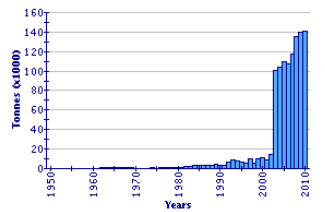
China is the largest producer of farmed Indo-Pacific swamp and mud crabs but the Philippines and Indonesia are also major producers, followed by Myanmar. However, the production of mud from other producing countries, such as India and Viet Nam, are not reflected in these data.
[Notes: 1. China did not report its aquaculture production of Indo-Pacific swamp crabs separately until 2003; thus the apparently massive but false global increase in that year. 2. The production data include the four species of Scylla: serrata, olivacea, paramamosain and tranquebarica.]
Market and Trade
Mud crabs are marketed live, except for soft-shell crabs. Mud crabs from farming or from the wild are sold to buying stations or traders; directly to consumers, including seafood restaurants; or to exporters. From the buying stations or traders, the bulk of the crab stocks are sold to exporters. Prices depend on the season, size, sex and gonad maturity. The highest priced crabs are the mature females with deep orange ovaries and fat immature or maturing females with yellow to light orange ovaries. The lowest priced are the crabs that are lacking claws as well as ovigerous or lean crabs, which are usually marketed locally. Live mud crabs are exported to Hong Kong, Singapore, Republic of Korea and Taiwan P.C.
For soft-shell crabs, the price depends on the size and condition of the crabs. The highest priced are those that are >200 g. The lowest priced are crabs which lack chelipeds, regardless of their size and those with slightly hardened shells. Soft-shell crabs are marketed locally or exported to Hong Kong, Singapore, Republic of Korea, Japan, Taiwan P.C., Europe and the United States of America and Pacific Islands Trust Territories. The cost ranges from USD 7.5-10.0/kg (5-15 count).
Status and Trends
There has been an increasing trend in mud crabs production during the last two decades (up to 2008). The total production of mud crabs from aquaculture in Asia and Africa was over 138 000 tonnes valued at nearly USD 377 million in 2008. With the establishment of hatcheries in some countries, worldwide mud crabs production is expected to continue to increase. To improve further the overall performance of mud crabs in captivity and to sustain the industry, the domestication of S. serrata has been initiated in the Philippines. The life cycle of Scylla spp. has been closed, a requirement for a domestication programme.
Main Issues
The main issues in swamp and mud crabs farming are:
- Lack of seedstock for the expanding industry.
- Cost effectiveness in seed production.
- Prevention of diseases in both hatchery (bacterial and fungal infections, and protozoan infestation) and grow-out (WSSV).
- Reduction of cannibalism from nursery to grow-out phase.
- Reduction in the use of low-value fish for feeding.
Responsible Aquaculture Practices
In general, mud crabs culture has little detrimental impact on the environment because stocking density is low due to its cannibalistic behaviour. As a result, the requirement of seedstock for farming and the occurrence of diseases are low, unlike those in marine shrimp farming.
The polyculture system utilizing natural food (snails, H. verticillata, filamentous algae and lablab) is sustainable. However, as the industry tries to expand, the availability of low value and other unprocessed feeds becomes a problem. Possible substitutes are low-value bivalves, agricultural by-products and recycled wastes such as fish offal. In many cases, mud crabs are used for the biological control of snails, which are considered pests in ponds.
Scylla species could contribute to environmental conservation through integration with mangroves and the reseeding of natural populations. Since new construction and pond utilization are not encouraged, mud crabs culture in mangrove areas where they co-exist is a more environmentally friendly approach. The nursery and fattening systems for mud crabs farming that are suitable for small-holder family-based businesses and rural communities are amenable to integration with mangroves. However, the constant collection of mud crabs seedstocks from the wild may result in recruitment failure.
Aside from FAO’s Code of Conduct for Responsible Fisheries, most countries have existing ordinance or legislation seeking to regulate the mud crabs fisheries and to improve aquaculture productivity within ecological limits. However, economic necessities and lack of financial support to implement such ordinance or legislation results in low-level compliance in many countries.
September 2012
In some cases antibiotics and other pharmaceuticals have been used in treatment but their inclusion in this table does not imply an FAO recommendation.




